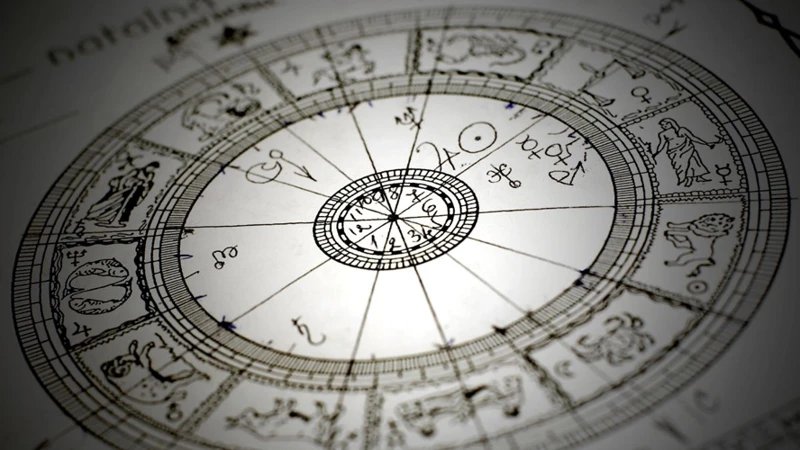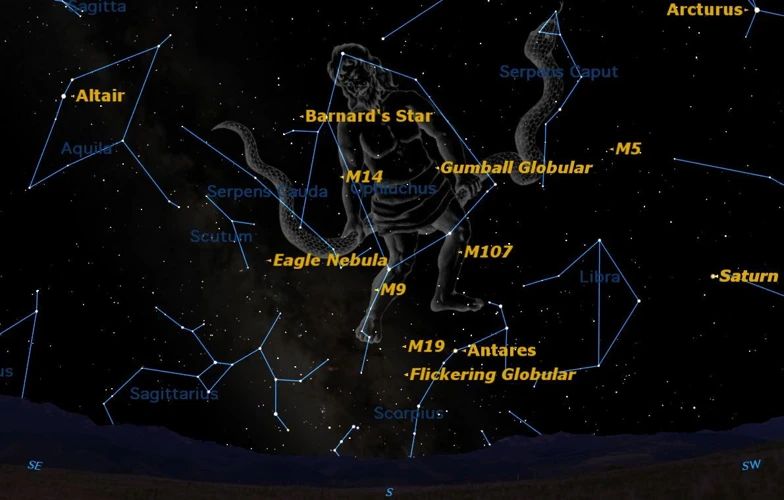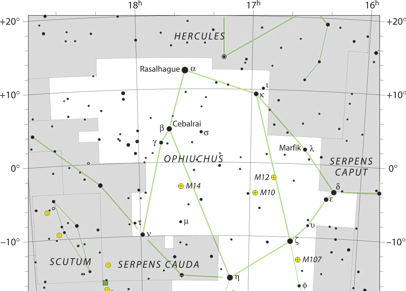Many people are familiar with the twelve signs of the zodiac, but there is one sign that often goes unnoticed and overlooked: Ophiuchus. This forgotten and mysterious sign holds a fascinating role in early astrological systems, yet it remains shrouded in ambiguity and controversy. In this article, we delve into the origins of astrology, explore the significance of Ophiuchus, and uncover the historical references and myths surrounding this enigmatic sign. Join us on a journey through the celestial realm as we shed light on the role of Ophiuchus in early astrological systems.
The Origin of Astrology

Astrology, the study of celestial bodies and their influence on human affairs, has a long and fascinating history that dates back thousands of years. Its origins can be traced to ancient civilizations such as Mesopotamia, Egypt, and Greece. The early practitioners of astrology observed the movement of the sun, moon, planets, and stars, and believed that these celestial entities held significant power and meaning. They developed complex systems and mathematical calculations to interpret the positions of these celestial bodies and their impact on human lives. Over time, astrology evolved and spread to different cultures, each adding their own interpretations and symbols to the astrological system. It became a prominent part of various civilizations, playing a role in everything from predicting the future to guiding important decisions. The ancient astrologers laid the foundation for the astrological systems we know today, and their contributions continue to shape our understanding of the stars and their influence on our lives. (Source: famous-astronomers-ophiuchus-study-contributions)
The Zodiac and Its Twelve Signs

The zodiac is a celestial band divided into twelve equal parts, known as signs, that encircles the Earth. Each sign corresponds to a specific period of the year and is associated with distinct characteristics and traits. The twelve signs of the zodiac are Aries, Taurus, Gemini, Cancer, Leo, Virgo, Libra, Scorpio, Sagittarius, Capricorn, Aquarius, and Pisces. These signs have been used for centuries as a means to understand and interpret individual personalities, life events, and compatibility between individuals. Astrologers believe that the position of the sun at the time of a person’s birth determines their zodiac sign, and thus, influences their behavior and destiny. While these twelve signs have long been recognized, there is another sign that often remains overlooked and forgotten – Ophiuchus. (Source: secrets-of-ophiuchus-revealed-historical-texts)
Ophiuchus: The Forgotten Sign
Ophiuchus, the forgotten sign of the zodiac, remains a mystery to many. Nestled between Scorpio and Sagittarius, Ophiuchus symbolizes a serpent-holder or healer in ancient Greek mythology. Despite its intriguing symbolism and historical significance, Ophiuchus has often been overlooked in traditional astrology. The reasons for this neglect are multifaceted. One reason is the historical association of astrology with twelve zodiac signs, omitting Ophiuchus from the traditional lineup. This omission can be attributed to ancient astrologers’ desire for symmetry and alignment with the number twelve. Another factor is the limited availability of information on Ophiuchus in historical astrological texts. However, with the resurgence of interest in astrology and the rediscovery of ancient texts, Ophiuchus is gradually gaining recognition. Modern astrologers are exploring the characteristics and influence of this elusive sign, shedding light on its unique attributes and contributions to the zodiac system. (Source: ophiuchus-renaissance-art-historical-analysis)
The Influence of Ophiuchus

Ophiuchus, despite being often overlooked, holds a significant influence in astrology. This mystical sign is known as the Healer and the Sage, embodying qualities of wisdom, knowledge, and holistic healing. Ophiuchus possesses a deep understanding of the human condition and is associated with spiritual growth and transformation. Its influence brings forth the power of healing, both physical and emotional, and encourages individuals to embrace their inner wisdom and seek enlightenment. Additionally, Ophiuchus serves as a bridge between the neighboring signs of Scorpio and Sagittarius, creating a harmonious connection between these two energies. Those born under Ophiuchus are said to possess a unique blend of the intense passion of Scorpio and the adventurous spirit of Sagittarius, making them natural seekers of truth and harboring a penchant for exploring life’s mysteries. As we delve deeper into the realm of astrology, it becomes clear that Ophiuchus holds a profound influence that cannot be dismissed.
Ophiuchus: A Healer and a Sage
Ophiuchus, the serpent bearer, is more than just a forgotten sign in astrology. It is associated with the archetype of a healer and a sage. In ancient times, Ophiuchus represented the Greek god Apollo, the god of medicine, healing, and prophecy. This sign signifies a deep connection to the healing arts and a profound understanding of the human condition. Those born under the sign of Ophiuchus are believed to possess innate healing abilities and a keen intuition that allows them to provide guidance and solace to others. With their natural empathy and wisdom, Ophiuchus individuals have the potential to bring about emotional and spiritual healing in those around them. They are often driven by a desire to make a positive difference in the world through their healing practices. Ophiuchus symbolizes the intertwining of medicine, spirituality, and wisdom, making it a unique and essential element in astrological systems.
Ophiuchus: Bridging the Gap between Scorpio and Sagittarius
Ophiuchus, often depicted as a serpent-bearer or a man wrestling with a snake, holds a unique position in the astrological system as it bridges the gap between the signs of Scorpio and Sagittarius. Traditionally, Scorpio is associated with intensity, mystery, and transformation, while Sagittarius embodies qualities of adventure, exploration, and expansiveness. Ophiuchus serves as a connector, blending the traits of both signs and offering a unique energy to those born under its influence. Individuals with Ophiuchus in their birth charts are said to possess a mix of the intensity and magnetic presence of Scorpio, along with the optimism and philosophical nature of Sagittarius. This blending of characteristics gives Ophiuchus individuals a multifaceted personality, capable of bringing together aspects of emotional depth and intellectual curiosity. They are often seen as seekers of truth, passionate about spiritual growth and healing. Ophiuchus reminds us that life is a journey of constant transformation and discovery, inviting us to embrace the dynamic nature of our existence and find balance within ourselves.
The Historical Significance of Ophiuchus

The historical significance of Ophiuchus can be seen through its references in ancient texts and constellations. In ancient Egyptian and Babylonian astrology, Ophiuchus was associated with Imhotep, an Egyptian deity known as the god of healing and medicine. Imhotep was revered as a sage and a wise healer, embodying the qualities that Ophiuchus is believed to possess. Additionally, Ophiuchus is linked to various constellations, such as Serpens Caput and Serpens Cauda, which symbolize the serpent bearer. These connections highlight the importance of Ophiuchus as a celestial figure in different cultures throughout history. Its symbolism and mythology have intrigued scholars and continue to be subjects of fascination and study. (Source: secrets-of-ophiuchus-revealed-historical-texts)
References in Ancient Texts and Constellations
Ancient texts and constellations provide intriguing references to the enigmatic sign of Ophiuchus. One such reference can be found in the famous astronomer Ptolemy’s work, called the Almagest. In this ancient text, Ptolemy mentions Ophiuchus as one of the thirteen constellations situated along the ecliptic, the path of the sun. The constellation is depicted as a man holding a serpent, symbolizing the transformative power of healing and wisdom. Additionally, the ancient Egyptians associated the constellation with Imhotep, a deified healer and architect. Imhotep, renowned for his wisdom and medical skills, was regarded as a divine figure and considered the patron of healers. The presence of Ophiuchus in these ancient texts and constellations highlights its significance in early astrological systems and its association with healing and knowledge. Through these references, Ophiuchus emerges as a celestial symbol of transformation and wisdom, adding depth and intrigue to the astrological landscape. (Source: secrets-of-ophiuchus-revealed-historical-texts)
Symbolism and Mythology Surrounding Ophiuchus
Symbolism and mythology surrounding Ophiuchus play a significant role in understanding the enigmatic nature of this forgotten zodiac sign. In ancient Greek mythology, Ophiuchus is associated with the legendary healer Asclepius, who possessed immense knowledge of medicine and the ability to resurrect the dead. The symbol of Ophiuchus is often depicted as a man holding a serpent, representing the pursuit of wisdom and healing. This symbolism aligns with the characteristics attributed to Ophiuchus, as individuals born under this sign are believed to possess profound intuitive and healing abilities.
Ophiuchus is commonly associated with the serpent and the staff, which intertwine to form the Caduceus, a symbol widely recognized in the medical field today. This further emphasizes the healing and transformative qualities attributed to Ophiuchus.
In addition to Greek mythology, Ophiuchus has links to Egyptian mythology, where it is connected to the deity Imhotep, known as the god of healing and medicine. Imhotep was revered as a wise sage and a skilled physician, similar to the attributes associated with Ophiuchus.
The symbolism and mythology surrounding Ophiuchus highlight its significance as a symbol of healing, wisdom, and transformation. It serves as a reminder of the interconnectedness between the celestial and terrestrial realms, emphasizing the impact of cosmic energies on human existence. (Source: secrets-of-ophiuchus-revealed-historical-texts)
The Ophiuchus Controversy
The Ophiuchus controversy revolves around the inclusion or exclusion of this elusive zodiac sign in modern astrology. While Ophiuchus was recognized by early astrologers, it was eventually removed from the list of official signs, leaving only twelve. However, in recent years, there has been a resurgence of interest in Ophiuchus, leading to debates and discussions among astrologers and enthusiasts. Some argue that Ophiuchus should be reinstated as the thirteenth zodiac sign, as its presence in the sky and its astrological characteristics cannot be ignored. Others maintain that the inclusion of Ophiuchus would disrupt the established system and create confusion among followers of astrology. The controversy continues to spark curiosity and speculation, serving as a reminder of how astrology, like any other field, is subject to interpretation and evolving perspectives.
Rejection and Rediscovery
The rejection and rediscovery of Ophiuchus is a fascinating chapter in the history of astrology. Despite being included in ancient astrological systems, Ophiuchus was largely forgotten and excluded from the traditional zodiac. This omission can be attributed to the standardization of the zodiac in Hellenistic astrology, which focused on the twelve signs we are familiar with today. For centuries, Ophiuchus remained hidden in plain sight, overshadowed by its neighboring signs of Scorpio and Sagittarius. However, in recent years, there has been a resurgence of interest in Ophiuchus, as astrologers and enthusiasts have sought to explore its significance and reintegrate it into astrological practices. This rediscovery has sparked debates and discussions, with some arguing for the inclusion of Ophiuchus as the thirteenth zodiac sign. While there is no consensus in the astrological community, the rejection and subsequent rediscovery of Ophiuchus have highlighted the fluid and ever-evolving nature of astrology. It serves as a reminder that our understanding of the stars and their influences is a constant journey of exploration and reinterpretation.
Ophiuchus in Modern Astrology
Ophiuchus, despite being largely forgotten for centuries, has experienced a resurgence of interest in modern astrology. While Ophiuchus is not officially recognized as one of the twelve zodiac signs in Western astrology, some astrologers have included it as a thirteenth sign. This inclusion is based on the astronomical fact that the sun passes through the constellation of Ophiuchus for a brief period each year, overlapping with neighboring Scorpio and Sagittarius. Those who align with this new interpretation of Ophiuchus believe that it represents traits such as wisdom, healing, and transformation. They argue that these attributes can complement and enhance the characteristics of the existing zodiac signs. However, it’s important to note that not all astrologers share this perspective. There is ongoing debate within the astrological community regarding the validity and significance of Ophiuchus as a distinct sign. Some argue that incorporating Ophiuchus disrupts the traditional system and dilutes its integrity, while others embrace the opportunity to expand the horizons of astrology and explore new possibilities. Regardless of differing opinions, Ophiuchus’s presence in modern astrology has sparked curiosity and engaged both enthusiasts and skeptics in pondering its potential significance and impact. (Source: “Ophiuchus in Modern Astrology”)
Conclusion
In conclusion, Ophiuchus, the forgotten sign of the zodiac, offers a captivating glimpse into the rich tapestry of early astrological systems. Despite its omission from the traditional twelve signs, Ophiuchus holds its own significance and symbolism. This healer and sage bridges the gap between Scorpio and Sagittarius, offering a unique blend of traits and energies. Throughout history, references to Ophiuchus can be found in ancient texts and constellations, further emphasizing its historical significance. The symbolism and mythology surrounding Ophiuchus add an intriguing layer to its story, making it a subject of fascination for astrologers and enthusiasts alike. While there may be controversy surrounding its inclusion in modern astrology, the rediscovery of Ophiuchus has sparked renewed interest and exploration. As we continue to unravel the mysteries of the stars and their influence on our lives, Ophiuchus serves as a reminder of the vastness and complexity of the astrological realm. Whether it be through historical texts, constellation art, or ongoing research, the story of Ophiuchus will undoubtedly continue to captivate and intrigue generations to come.
Frequently Asked Questions
1. What is astrology?
Astrology is the study of celestial bodies, their movements, and their influence on human affairs. It involves interpreting the positions and relationships of the sun, moon, planets, and stars to gain insight into various aspects of life and personality traits.
2. How old is astrology?
Astrology has roots that date back thousands of years. It originated in ancient civilizations like Mesopotamia, Egypt, and Greece, and has evolved and spread to different cultures over time.
3. What is the zodiac?
The zodiac is a band of the celestial sphere divided into twelve equal parts, each corresponding to a specific sign. It is believed to represent the path that the sun takes through the sky over the course of a year.
4. What are the twelve signs of the zodiac?
The twelve signs of the zodiac are Aries, Taurus, Gemini, Cancer, Leo, Virgo, Libra, Scorpio, Sagittarius, Capricorn, Aquarius, and Pisces. Each sign is associated with specific personality traits and characteristics.
5. What is Ophiuchus?
Ophiuchus is a forgotten sign of the zodiac, often represented as a serpent-bearer or a healer. It lies between Scorpio and Sagittarius, but its inclusion in the zodiac is a subject of controversy.
6. What is the role of Ophiuchus in early astrological systems?
Ophiuchus played a significant role in early astrological systems, bridging the gap between Scorpio and Sagittarius. It was believed to symbolize healing and wisdom, representing a bridge between earthly and divine realms.
7. Are there references to Ophiuchus in ancient texts and constellations?
Yes, there are references to Ophiuchus in various ancient texts and constellations. For example, it is mentioned in the writings of Ptolemy and has been depicted in ancient artwork as a prominent figure.
8. What are the myths and symbolism surrounding Ophiuchus?
Ophiuchus is associated with various myths and symbols, often representing the power of healing and the balance between life and death. It is sometimes linked to the myth of Asclepius, the Greek god of medicine.
9. What is the controversy surrounding Ophiuchus?
The controversy surrounding Ophiuchus stems from its exclusion from the traditional twelve signs of the zodiac. While some astrologers advocate for its inclusion, others argue that it disrupts the established system.
10. How is Ophiuchus viewed in modern astrology?
In modern astrology, Ophiuchus is still a subject of debate and exploration. Some astrologers consider it as a thirteenth zodiac sign, while others see it as an astronomical constellation that doesn’t directly influence astrological interpretations.








